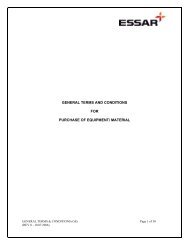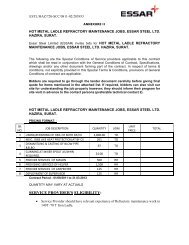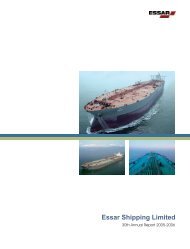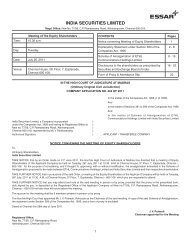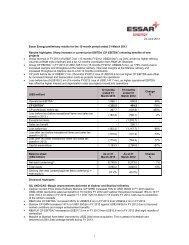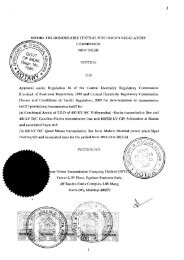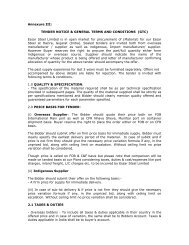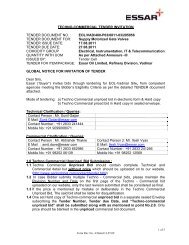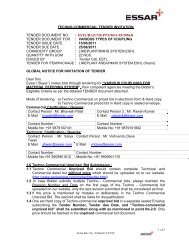Create successful ePaper yourself
Turn your PDF publications into a flip-book with our unique Google optimized e-Paper software.
NOTES TO THE FINANCIAL STATEMENTSAt 31st March 20081 ACTIVITIESEssar Steel Trading FZE (the “Establishment”) was incorporated asa Free Zone Establishment with limited liability on 14 June 2006 inthe Dubai Airport Free Zone pursuant to Law No. (2) of 1996 andits amendment No. (2) of 2000 issued by Dubai Airport Free ZoneAuthority. The business address of the Establishment is P O Box61078, Dubai, United Arab Emirates.The Establishment is engaged in the activity of trading in steel andconstruction materials.The Establishment is a wholly owned subsidiary of EssarSteel Limited, a company registered in India, which exercisesmanagement control over the operating and financing decisions ofthe Establishment.2 SIGNIFICANT ACCOUNTING POLICIESBasis of preparationThe financial statements have been prepared in accordancewith International Financial Reporting Standards and applicablerequirements of United Arab Emirates law.The financial statements have been prepared in United StatesDollars, being the functional currency of the Establishment.The financial statements have been prepared under the historicalcost convention.Changes in accounting policiesThe accounting policies are consistent with those used in theprevious year except as follows:The Establishment has adopted the following new and amendedIFRS and IFRIC interpretations during the year. Adoption of theserevised standards and interpretation did not have any effect on thefinancial performance or position of the Establishment. They didhowever give rise to additional disclosures:• IFRS 7 Financial Instruments: Disclosures• IAS 1 Amendment - Presentation of financial statementsIFRS 7 Financial Instruments DisclosuresThis standard requires disclosures that enable users of the financialstatements to evaluate the significance of the Establishment’sfinancial instruments and the nature and extent of risks arising outof those financial instruments. The new disclosures are includedthroughout the financial statements.IAS 1 – Amendment - Presentation of financial statementsThis amendment requires the Establishment to make newdisclosures to enable users of the financial statements to evaluatethe Establishment’s objectives, policies and processes for managingcapital. These new disclosures are shown in Note 12.IASB Standards and Interpretation issued but not adoptedThe Establishment has not adopted the new accounting standardsor interpretations that have been issued but are not yet effective.These standards and interpretations, except for revised IAS 1 arenot likely to have any significant impact on the financial statementsof the Establishment in the period of their initial application.The Establishment has not adopted the revised IAS 1 “Presentationof Financial Statements” which will be effective for the year ending31st March 2009. The application of this standard will result inamendments to the presentation of the financial statements.Revenue recognitionRevenue from sales of goods is recognised when the significantrisks and rewards of ownership of the goods have passed to thebuyer and the amount of revenue can be measured reliably.Interest revenue is recognised as the interest accrues usingthe effective interest method, under which the rate used exactlydiscounts estimated future cash receipts through the expected lifeof the financial asset to the net carrying amount of the financialasset.Commission income is accounted for on an accruals basis.Impairments of financial assetsAn assessment is made at each balance sheet date to determinewhether there is objective evidence that a specific financial assetmay be impaired. If such evidence exists, any impairment loss isrecognised in the income statement. Impairment is determined asfollows:(a) For assets carried at fair value, impairment is the differencebetween cost and fair value, less any impairment loss previouslyrecognised in the income statement;(b) For assets carried at cost, impairment is the difference betweencarrying value and the present value of future cash flowsdiscounted at the current market rate of return for a similarfinancial asset;(c) For assets carried at amortised cost, impairment is thedifference between carrying amount and the present value offuture cash flows discounted at the original effective interestrate.Accounts receivableTrade receivables are stated at original invoice amount less aprovision for any uncollectible amounts. An estimate for doubtfulaccounts is made when collection of the full amount is no longerprobable. Bad debts are written off when there is no possibility ofrecovery.Cash and cash equivalentsFor the purpose of the Statement of Cash Flows, cash and cashequivalents consist of cash in hand, bank balances, and short-termdeposits with an original maturity of three months or less, net ofoutstanding bank overdrafts.Accounts payable and accrualsLiabilities are recognised for amounts to be paid in the future forgoods or services received, whether billed by the supplier or not.ProvisionsProvisions are recognised when the Establishment has an obligation(legal or constructive) arising from a past event, and the coststo settle the obligation are both probable and able to be reliablymeasured.Term loansTerm loans are recognised at the fair value of the proceeds received,net of transaction costs incurred. Term loans are subsequentlystated at amortised cost using the effective yield method. Thedifference between proceeds (net of transaction costs) and theredemption value is recognised in the income statement over theperiod of the loan.61



